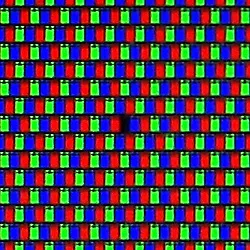When you buy a new electronic device with a nice screen, one of the first things you should do is a dead pixel test. It doesn’t matter if it has an LCD or OLED panel. You never know what type of defects can come from the warehouse, during shipping, and after sitting on the shelf.
So today I’ll be taking a moment to show you all how I tested my OLED Steam Deck for stuck and dead pixels.
What’s a Stuck Pixel?
A stuck pixel is a dot on an electronic screen that doesn’t render the correct color. The pixel is referred to as being “stuck” because it’s fixed on a specific color, such as red, green, blue, yellow, or black. You can test this by filling up the display with one single color. If all of the pixels are working correctly then there will not be any inconsistencies when you look over the screen from corner to corner.
So if you have an program or a website that will fill the screen with the color blue, for example, you can check to make sure they are all working correctly.
If you end up seeing a pixel displaying a non-blue pixel then you’ll know there is something wrong. After you have checked the screen for that color, you’ll then move onto the next one. Continue as you go from White to Black to Red to Green to Blue and then back to White again.
In some instances a stuck pixel is due to it being overworked. So a stuck pixel could fix itself after it is able to “relax” in an off-state for 12-24 hours.

What About a Dead Pixel?
On the other hand, a dead pixel is one within your display panel that is unable to be lit up. It’s possible that this means one specific color is just out and that it will display all others perfectly fine. However, it could also mean that the entire area of pixels are just unable to be lit up. This tends to result in a pixel showing up a black (or white) spot with the remaining colors around it continuing to work fine.
This tends to be more serious than a stuck pixel since it is often a sign of the hardware going bad (or already broken)
If your Steam Deck has a dead pixel then it is usually advised to RMA it for a new one. Some companies will refuse to replace a device unless there are multiple dead pixels. . .or when the percentage of dead pixels surpasses a specific amount. I haven’t heard of Valve being this way with the launch of the OLED model, but let me know if this ends up changing in the future.
How to Check the Steam Deck for Dead Pixels?
There may actually be a dedicated application for Linux that will help you to check for Dead Pixels. But I found the easiest way is to visit a website on the Steam Deck that hosts a pixel test with colors. So here is how I checked my Steam Deck for stuck and dead pixels.
- Switch to Desktop Mode
- Launch a Web Browser (installed through the Discover app)
- Visit the LCDTech test website.
- Tap or click the “Start Test” button.
- Then closely examine the entire screen.
- Tap the screen to switch to the next color.
- And then carefully examine the display from edge to edge again.
- Repeat until the colors loop.
If you can find a way to display these colors across the entire display in an easier way, then please share that with the community 🙂
Sadly, Valve does not have a web browser pre-installed on the Steam Deck (at least not right now). But the Discover app makes it very easy to install a popular browser like Firefox or Chrome. Then you just have to visit that website to begin the test.
My advise is to take your time as you carefully look over the display. There’s no need to rush with any color in this test so be sure to inspect every pixel. It can even be a good idea to get really close to the Steam Deck, too, so that you’re able to get a good look at the small details.
Checking the Steam Deck for Dead Pixels
Conclusion
I have read that Steam Decks with a Samsung display tend to have fewer dead pixels than those that come from BOE. Then again, it’s the BOE displays that are actually able to be overclocked to 120Hz. So Samsung is doing a much better job at Quality Control than BOE. . .but BOE seems to be able to produce a better product (when comparing these two specific units).
I would actually be very interested in seeing a full comparison between the two panels.